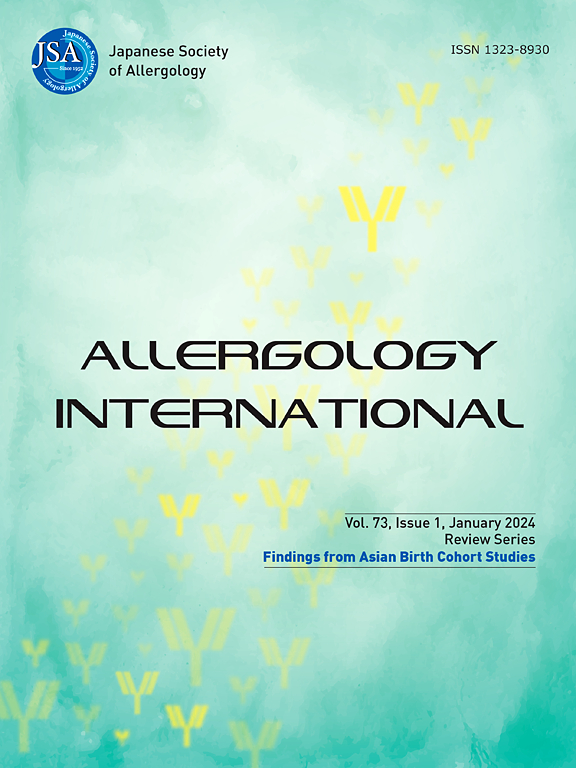利格珠单抗治疗日本慢性自发性荨麻疹患者的长期安全性和有效性。
IF 6.7
2区 医学
Q1 ALLERGY
引用次数: 0
摘要
背景:在日本,荨麻疹是一种常见的皮肤疾病,其中慢性自发性荨麻疹(CSU)是最常见的亚型。本研究评估了利格珠单抗(抗 IgE 单克隆抗体)在日本 CSU 患者中的安全性:这是一项为期52周的3期多中心、开放标签、单臂研究,研究对象为使用当地批准剂量的H1-抗组胺药物治疗效果不佳的日本成年CSU患者。研究的首要目标是通过评估治疗突发不良事件(TEAE)来评价利格珠单抗120毫克皮下注射每4周一次的安全性。次要目标通过每周荨麻疹活动评分(UAS7)与基线(CFB)相比的绝对值变化、UAS7=0的患者比例以及皮肤科生活质量指数(DLQI)=0-1来评估疗效:共有66名CSU患者(80.3%为女性;平均(±SD)年龄为46.4±13.2岁;平均(±SD)基线UAS7为28.7±6.5)参加了研究,其中53名患者(80.3%)在研究期间报告了≥1次TEAE,无严重不良事件,无过敏性休克事件,导致治疗中断的TEAE发生率较低(6.1%)。UAS7的绝对平均CFB在第4周(-14.2)出现快速反应,并在第52周(-22.9)治疗结束前进一步改善。随着时间的推移,达到 UAS7 = 0 的患者比例有所提高(第 4 周为 14.5%;第 52 周为 50.0%)。相当大比例的患者在首次服用利格珠单抗时达到了DLQI 0-1(38.5%),在整个研究过程中一直到第52周均有所改善(68.8%):利格珠单抗120毫克对日本患者的耐受性良好,不良反应轻微至中等,疗效显著。本文章由计算机程序翻译,如有差异,请以英文原文为准。
Long term safety and efficacy of ligelizumab in the treatment of Japanese patients with chronic spontaneous urticaria
Background
In Japan, urticaria is a common skin disorder with chronic spontaneous urticaria (CSU) being the most frequent subtype. This study evaluated the safety of ligelizumab (anti-IgE monoclonal antibody) in Japanese CSU patients.
Methods
This was a Phase 3 multicenter, open-label, single-arm 52-week study in adult Japanese patients with CSU inadequately controlled with locally approved doses of H1-antihistamines. The primary objective reported the safety of ligelizumab 120 mg subcutaneously every 4 weeks, by evaluation of treatment emergent adverse events (TEAE). Secondary objectives evaluated efficacy by absolute change from baseline (CFB) in weekly urticaria activity score (UAS7), and the proportion of patients with UAS7 = 0, and dermatology life quality index (DLQI) = 0–1 over time.
Results
From a total of 66 CSU patients (80.3% females; mean ± SD age 46.4 ± 13.2 years; mean ± SD baseline UAS7 28.7 ± 6.5) enrolled, 53 patients (80.3%) reported ≥1 TEAE during the study, with no severe or serious adverse events, no anaphylaxis events and low frequency of TEAEs leading to treatment discontinuations (6.1%). Absolute mean CFB of UAS7 showed a rapid onset of response at Week 4 (−14.2) with further improvement until end of treatment at Week 52 (−22.9). The proportion of patients achieving UAS7 = 0 improved over time (14.5% at Week 4; 50.0% at Week 52). A sizable proportion of patients achieved DLQI 0–1 with the first dose of ligelizumab (38.5%), and improvements observed throughout the study until Week 52 (68.8%).
Conclusions
Treatment with ligelizumab 120 mg was well-tolerated with mild to moderate adverse events and was efficacious in Japanese patients.
求助全文
通过发布文献求助,成功后即可免费获取论文全文。
去求助
来源期刊

Allergology International
ALLERGY-IMMUNOLOGY
CiteScore
12.60
自引率
5.90%
发文量
96
审稿时长
29 weeks
期刊介绍:
Allergology International is the official journal of the Japanese Society of Allergology and publishes original papers dealing with the etiology, diagnosis and treatment of allergic and related diseases. Papers may include the study of methods of controlling allergic reactions, human and animal models of hypersensitivity and other aspects of basic and applied clinical allergy in its broadest sense.
The Journal aims to encourage the international exchange of results and encourages authors from all countries to submit papers in the following three categories: Original Articles, Review Articles, and Letters to the Editor.
 求助内容:
求助内容: 应助结果提醒方式:
应助结果提醒方式:


